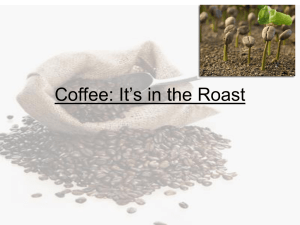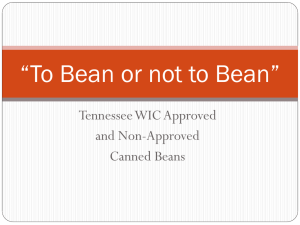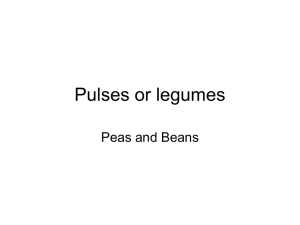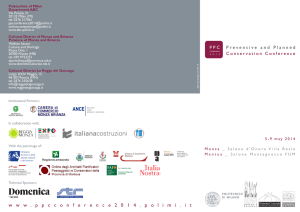Production through Export
advertisement
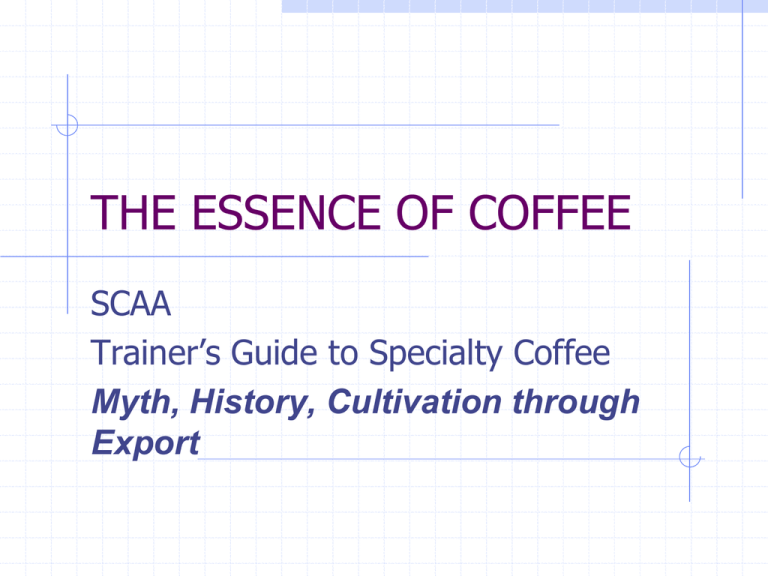
THE ESSENCE OF COFFEE SCAA Trainer’s Guide to Specialty Coffee Myth, History, Cultivation through Export COFFEE BASICS: Production through Export The Cherry to Bean Ratio Processing Wet Process Fermentation Drying Dry Process Wet vs. Dry Milling or Hulling Polishing Final Sorting Grading European Prep Storage and Shipping Aged Coffee PRODUCTION THROUGH EXPORT Depending on the system of hand picking used as well as the layout of the farm, a picker can pick approximately 100 to 200 pounds of coffee cherries each day. Since only about 20% of this weight consists of actual bean weight, the average net yield per picker per day is 20 to 40 pounds of green beans. This is remarkable as is the fact that each coffee tree annually yields the equivalent of 1 to 1 1/2 pounds of roasted coffee! freshly picked red coffee cherries Processing The next phase in coffee’s journey is the processing. Processing is the system of separating the bean from its outer skins. The two processes used are the Wet (or Washed) Process and the Dry (or Natural) Process. The Wet Process primarily is used for arabicas while the Dry Process is most often used for robustas. The processing method used plays a huge role in helping to determine the coffee bean’s brewed flavor. Coffees that undergo Wet Processing that include fermentation typically yield greater acidity. Wet Processing Wet Process In the Wet Process, coffee cherries first are sent through a pulping machine. Cherries must go to the pulping machine between 12 to 24 hours after harvest. To wait too long is to risk significant deterioration in the cup quality of the coffee. The pulping machine uses either blades or a fixed surface working with a moving surface to smash the coffee cherry in order to remove the cherry’s outer skin and most of the pulp. pulping machine defect and density separation Fermentation The coffee beans are soaked for 12 to 36 hours in fermentation tanks in order to remove the sticky coating around the bean called the mucilage. The fermentation process requires delicate balance. While fermentation produces enzymes, which allow the mucilage to loosen from the bean, it also can occur for too long and cause rot. fermentation tank It takes only 1 rotten bean to ruin a whole batch of beans! After fermentation, the beans are thoroughly cleaned in washing channels to remove any remaining fruit residue. As the beans move through the washing channels, “floaters” are sorted out due to their low density and poor quality. washing channel Drying Still encased in their parchment, the coffee beans are sun dried to a degree of moisture at which they will be stabilized for shipment. For arabica beans, this is 9-13%. This drying process begins by spreading the parchment-encased coffee beans on concrete patios or on drying trays or tables at a depth of about 2 inches. beans in parchment Over the course of 3-5 days, the beans are raked constantly in order to ensure even drying. Throughout the course of the day, beans are raked in the direction of the sun in order to most effectively harness the sun’s hottest rays. When insufficient labor and/or weather conditions prohibit it, sun drying sometimes is supplemented with machine dryers. raking on the drying patio These dried beans, now called parchment coffee, will remain in this form until just prior to shipping for export. If the coffee is under dried, it can spoil. If the coffee beans are over dried, some of the quality may be lost. Once again, this is a story of balance. coffee dryer Dry Process The Dry Process is the most traditional and least expensive of the 2 methods. The Wet Process relies on an abundant water supply. Countries lacking a wealth of water, such as Brazil and Ethiopia, use the Dry Process. With this method, ripe coffee cherries are allowed to remain on the tree for an initial drying. preparing coffees in cherry skin for drying After the cherries are taken from the trees, they are spread out on concrete, tiled, or matted surfaces to a depth of about 2 inches. The cherries are left in the sun to dry. In order to keep them from fermenting or spoiling, the cherries are raked and turned frequently for approximately 14 to 21 days. Dry Process roof patio During the drying time, the cherries may be covered to protect them from rain or cold. At the end of the Dry Process, the coffee cherry skin continues to encase the beans now in a hard, dark shell. As with the Wet Process, it is important not to over or under dry the coffee. Once the beans have been dried to about 12% moisture content, they are stored in silos in order to continue the process for a bit longer. The drying component of both processing methods necessarily reduces the moisture content in the bean from about 60% to 9 to 13%. Wet Vs. Dry The characteristics of the beans processed by these 2 methods vary. Wet processed beans: Are blue/green to gray/green in color Have a clean flavor Lack undesirable elements Have greater acidity And tend to command a higher price due to the extra expense for labor and equipment Dry processed beans: Tend to be greenish to brownish in color Have heavier body And can develop offtastes Wet vs. Dry Milling or Hulling The milling, or hulling, process occurs just before the green beans are exported. This process is also referred to as “curing” the beans. Using either friction or impact hullers, the parchment and/or silver skin is removed from the bean. huller Friction hullers use rotors or knives to peel or grind the skins off of the beans. Impact hullers rely on wheels, pins, and the like to shatter the casing around the coffee bean. Both methods can be used for either Wet or Dry processed coffees. Polishing Polishing is sometimes used to remove any remaining silver skin on the bean. The methodology of polishing closely follows that of friction hulling. While polishing can make the bean look more attractive, the heat from this process can destroy the acidity, or brightness, in the coffee. polisher Final Sorting Coffee beans undergo a final sorting at origin where they are scrutinized by size, shape, density (the hardness of the bean), and by color (which ranges from bluish to brownish). Sorting is used to remove the defects from the coffee, which is being prepared for export. bean sorting Sorting also is used to batch coffees together, which possess similar physical characteristics. Such batching allows for consistent roasting quality. While coffee beans at this point undergo a rigorous series of final sortings, throughout processing unacceptable beans are removed upon detection. Peaberries too are sorted out to be sold separately and often at a premium price. Coffee beans are sorted by utilizing 3 methods. screen sorting The first method is gravity and screen sorting which separates beans by common density and size. Employing mechanized or hand held screens, beans of the designated size and weight fall through precisely sized openings. A simple mechanized system uses blasts of air aimed at the beans. The lightest, lowest density beans are lifted out of the pack by a blast of air and are subsequently removed as undesirable. Electronic Sorter A more sophisticated system is Electronic Sorting, which scans the beans as they pass in front of a photoelectric cell in order to measure the amount of light reflected off of each bean. Those beans that do not meet the proper criteria are sorted out. A more advanced version of this method uses a bichromatic light to analyze the proper color of the bean. Again, those not meeting the proper criteria are picked out. Ultra violet lights also are used in order to detect fermentation, which is not visible to the naked eye. hand inspection on conveyor belt The final method of sorting is to pick out the defects by hand as the beans pass over a conveyor belt. Defects include black beans, broken beans, stones, or debris found in a coffee sample. Once sorted, the beans are ready for grading. Grading Criteria for grading may include altitude of growth, density, and bean size of the bean. Each country of origin determines the criteria that it will use to sort, grade, and label their coffee beans. For example, Kenya identifies its top grade, AA, by the size of the bean. Another country, which grades its coffees by size, is Colombia. Here Supremo beans are larger than are Excelso beans. grading Costa Rica uses altitude as one grading and naming criterion. It categorizes Costa Rican Strictly Hard Bean (which grows at 3600 to 5200 feet above sea level) as superior to the Costa Rican Hard Bean, which is grown at a lower altitude. Other coffees carry the names of the ports through which they are commonly exported. An example of this is Yemen Mocha. And still others are given the name of the region in which they are grown—as is the case with Ethiopian Harrar. European Prep As we have seen, the care taken in the processing of the coffee beans, as in every other step of the cycle is critical in determining the quality that we find in our own cup. European Prep refers to the extra attention and care that is taken with some arabica beans to ensure that they are free of any and all potential defects. These coffees are given extra care in the washing process, in the scrutiny of defects, and in the hand sorting to ensure uniformity in bean size. Additionally, these beans are polished. This extra attention results in a price up to 10% higher than other high quality arabicas. Storage and Shipping Before coffee makes its final journey to export, it must be bagged in jute, hemp, or sisal bags (burlap) and in weights ranging from 100 pounds (or 45.36 kilos) to 152 pounds (or 69 kilos). The material for these bags is inexpensive and readily available in the countries of origin. It also provides valuable protection to the beans. Since these bags “breathe”, they do not trap any moisture in the beans, which can cause the beans to mold. bagging Typically, the country of origin, grade of bean, and the method of processing, are printed on the bag. bags in warehouse Ventilated warehouses often are provided for coffee storage in many countries of origin. These warehouses are designed to protect the green coffee beans from absorbing moisture and odors. Coffee labeled and stored as a “new crop” is one that has been harvested during the current crop year. A “past crop” label refers to a crop that has been harvested from a prior year. Typically these older crops are sold at a reduced price. Aged Coffee Certain coffees are stored in their parchment for several years. These coffees are being “aged” in order to develop a smoky characteristic created by the chemical changes within the beans. Aged Sumatra is one such coffee. Due to increased expense stemming from long-term storage, these aged coffees command premium prices. Shipping When coffees are bagged and ready for export, they are loaded in containers which each hold up to 250 bags of coffee. They are then shipped or in some cases flown to destinations around the world. loading the ship
